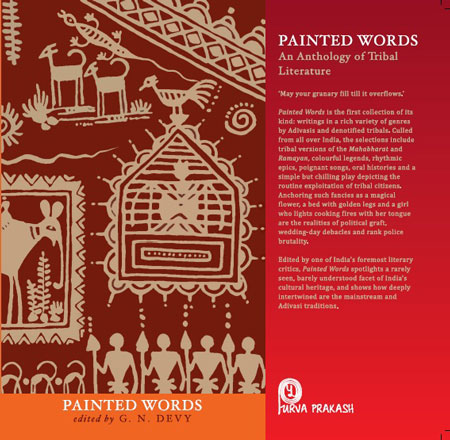Photo: courtesy Open Space – Ranchi
On 20th February, two documentaries were shown amongst the students of Class IX, in Sarna Adivasi Madhya Vidyalaya in Pisca, a suburb area of Ranchi. It was a tribal area, with almost ninety percent Oraon students.
When they saw ‘Kora Rajee’ (The Land of the Diggers) on the adivasi brothers / sisters of their’s who have migrated to Assam and North Bengal, they were very much touched. The story narration by Kurdula Kujur travelling with her son, tracing the same paths which was taken was interesting. From the labour depot of Dipugarh (Hazaribagh) to crossing the Ganges towards Siliguri and further very near to Bhutan, the scenes of the tea garden filled the young students with enthusiasm.
The second movie ‘Loha Garam Hai’ (Iron is Hot) was about the sponge iron plant in Orissa, its pollution and the people’s resistance building up. This was an edited version meant especially for school children (abusive language censored).
The film screening was followed by a response session. What was shown in the film? Was it something near to heart or to reality situations? This on-camera responses made the students ‘enthu’. First they were afraid of coming in front of the camera and later when encouraged 3-4 friends came together, to respond collectively. This exercise was carried in front of the 150 odd students. It was explained that this fear towards camera needs to break, with new technology coming so close to everybody, and the use of digital camera, mobile etc increasing.
In their responses Sushil Tirkey and Amita Kachchap said that there is regular migration from the area, though not as in the British times, when the labourers were booked from a depot. The government schemes like NREGA (National Rural Employment Guarantee Act) do not in any considerable manner reduce the out migration. Students said that men and women are constantly going to Delhi, UP and Gujarat. Many of them are outside Jharkhand for many years. Young boys and girls said that they have heard that some even do not come back. Concern for tribal unity on the basis of language was felt (though question was raised that many adivasis of the urban areas are forgetting their language and culture).
Opinions were expressed that such reality documentation (away from the Shahrukh Khan – Aishwarya Rai Cinema) about life of the Adivasis and its screening is an extremely good educational tool and such initiatives should be included in school curriculum.
(Wednesday, March 18, 2009)
Source: Open Space – Ranchi: Screening of Adivasi focused Films
URL: http://openspace-ranchi.blogspot.com/2009/03/screening-of-adivasi-focused-films.html
Date Visited: 13 June 2022
[Bold typeface added above for emphasis]
Tips for using interactive maps
Toggle to normal view (from reader view) should the interactive map not be displayed by your tablet, smartphone or pc browser
For details and hyperlinks click on the rectangular button (left on the map’s header)
Scroll and click on one of the markers for information of special interest
Explore India’s tribal cultural heritage with the help of another interactive map >>
See also
Adverse inclusion | Casteism | Rural poverty
Demographic Status of Scheduled Tribe Population of India (Census figures 2011)
Fact checking | Figures, census and other statistics
Human Rights Commission (posts) | www.nhrc.nic.in (Government of India)
Search tips | Names of tribal communities, regions and states of India
“What is the Forest Rights Act about?” – Campaign for Survival and Dignity
“Who are Scheduled Tribes?” – Government of India (National Commission for Scheduled Tribes, NCST)
“India, a union of states, is a Sovereign, Secular, Democratic Republic with a Parliamentary system of Government. The President is the constitutional head of Executive of the Union. In the states, the Governor, as the representative of the President, is the head of Executive. The system of government in states closely resembles that of the Union. There are 28 states and 8 Union territories in the country. Union Territories are administered by the President through an Administrator appointed by him/her. From the largest to the smallest, each State/UT of India has a unique demography, history and culture, dress, festivals, language etc. This section introduces you to the various States/UTs in the Country and urges you to explore their magnificent uniqueness…” – KnowIndia (Government), States and Union Territories (Visited: 2 September 2023)
Learn more about India’s 28 States and 8 Union Territories – From Andhra Pradesh to West Bengal | Nutrition >>

“We have to write our own stories, about our issues, from our own perspectives.” – Abhay Xaxa, a “Fiercely Unapologetic Adivasi Scholar-Activist” | Read more >>
Learn more
Chotanagpur | Chota Nagpur | Fact checking
Colonial policies | Freedom Struggle | Independence
Communities: Asur | Ho| Kharia | Munda | Oraon | Santal | State wise ST list (Scheduled Tribes)
Forest Rights Act (FRA) | Legal rights over forest land
Hul (Santal rebellion 1855-1856) | Tribal freedom fighters
Video | Hul Sengel: The Spirit of the Santal Revolution (1855) – Jharkhand
